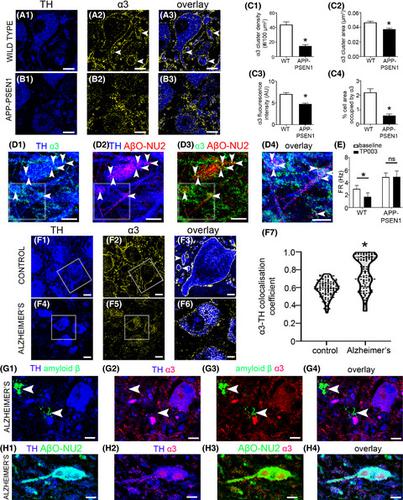当前位置:
X-MOL 学术
›
Neuropathol. Appl. Neurobiol.
›
论文详情
Our official English website, www.x-mol.net, welcomes your
feedback! (Note: you will need to create a separate account there.)
Identification of intraneuronal amyloid beta oligomers in locus coeruleus neurons of Alzheimer’s patients and their potential impact on inhibitory neurotransmitter receptors and neuronal excitability
Neuropathology and Applied Neurobiology ( IF 4.0 ) Pub Date : 2020-12-20 , DOI: 10.1111/nan.12674 Louise Kelly 1 , Mohsen Seifi 1, 2 , Ruolin Ma 1 , Scott J Mitchell 3 , Uwe Rudolph 4 , Kirsten L Viola 5 , William L Klein 5 , Jeremy J Lambert 3 , Jerome D Swinny 1
Neuropathology and Applied Neurobiology ( IF 4.0 ) Pub Date : 2020-12-20 , DOI: 10.1111/nan.12674 Louise Kelly 1 , Mohsen Seifi 1, 2 , Ruolin Ma 1 , Scott J Mitchell 3 , Uwe Rudolph 4 , Kirsten L Viola 5 , William L Klein 5 , Jeremy J Lambert 3 , Jerome D Swinny 1
Affiliation

|
AIMS
Amyloid β oligomers (AβO) are potent modulators of Alzheimer's pathology, yet their impact on one of the earliest brain regions to exhibit signs of the condition, the locus coeruleus (LC), remains to be determined. Of particular importance is whether AβO impact the spontaneous excitability of LC neurons. This parameter determines brain-wide noradrenaline (NA) release, and thus NA-mediated brain functions, including cognition, emotion and immune function, which are all compromised in Alzheimer's. Therefore, the aim of the study was to determine the expression profile of AβO in the LC of Alzheimer's patients and to probe their potential impact on the molecular and functional correlates of LC excitability, using a mouse model of increased Aβ production (APP-PSEN1). METHODS AND RESULTS
Immunohistochemistry and confocal microscopy, using AβO-specific antibodies, confirmed LC AβO expression both intraneuronally and extracellularly in both Alzheimer's and APP-PSEN1 samples. Patch clamp electrophysiology recordings revealed that APP-PSEN1 LC neuronal hyperexcitability accompanied this AβO expression profile, arising from a diminished inhibitory effect of GABA, due to impaired expression and function of the GABA-A receptor (GABAA R) α3 subunit. This altered LC α3-GABAA R expression profile overlapped with AβO expression in samples from both APP-PSEN1 mice and Alzheimer's patients. Finally, strychnine-sensitive glycine receptors (GlyRs) remained resilient to Aβ-induced changes and their activation reversed LC hyperexcitability. CONCLUSIONS
The data suggest a close association between AβO and α3-GABAA Rs in the LC of Alzheimer's patients, and their potential to dysregulate LC activity, thereby contributing to the spectrum of pathology of the LC-NA system in this condition.
中文翻译:

阿尔茨海默病患者蓝斑神经元中神经元内β淀粉样蛋白寡聚物的鉴定及其对抑制性神经递质受体和神经元兴奋性的潜在影响
β 淀粉样蛋白寡聚体 (AβO) 是阿尔茨海默病病理学的有效调节剂,但它们对最早出现该病症状的大脑区域之一蓝斑 (LC) 的影响仍有待确定。特别重要的是 AβO 是否影响 LC 神经元的自发兴奋性。该参数决定全脑去甲肾上腺素 (NA) 的释放,从而决定 NA 介导的大脑功能,包括认知、情绪和免疫功能,这些功能在阿尔茨海默病中都会受到损害。因此,本研究的目的是使用 Aβ 生成增加的小鼠模型 (APP-PSEN1) 确定阿尔茨海默病患者 LC 中 AβO 的表达谱,并探讨其对 LC 兴奋性的分子和功能相关性的潜在影响。 。方法和结果免疫组织化学和共聚焦显微镜,使用 AβO 特异性抗体,证实了阿尔茨海默病和 APP-PSEN1 样本中神经元内和细胞外的 LC AβO 表达。膜片钳电生理学记录显示,APP-PSEN1 LC 神经元过度兴奋伴随着这种 AβO 表达谱,这是由于 GABA-A 受体 (GABAA R) α3 亚基的表达和功能受损而导致 GABA 抑制作用减弱所致。这种改变的 LC α3-GABAA R 表达谱与 APP-PSEN1 小鼠和阿尔茨海默病患者样本中的 AβO 表达重叠。最后,士的宁敏感的甘氨酸受体 (GlyR) 对 Aβ 诱导的变化保持弹性,并且它们的激活逆转了 LC 的过度兴奋。结论 数据表明,阿尔茨海默氏症患者 LC 中的 AβO 和 α3-GABAA R 之间存在密切关联,并且它们有可能失调 LC 活性,从而导致这种情况下 LC-NA 系统的病理谱。
更新日期:2020-12-20
中文翻译:

阿尔茨海默病患者蓝斑神经元中神经元内β淀粉样蛋白寡聚物的鉴定及其对抑制性神经递质受体和神经元兴奋性的潜在影响
β 淀粉样蛋白寡聚体 (AβO) 是阿尔茨海默病病理学的有效调节剂,但它们对最早出现该病症状的大脑区域之一蓝斑 (LC) 的影响仍有待确定。特别重要的是 AβO 是否影响 LC 神经元的自发兴奋性。该参数决定全脑去甲肾上腺素 (NA) 的释放,从而决定 NA 介导的大脑功能,包括认知、情绪和免疫功能,这些功能在阿尔茨海默病中都会受到损害。因此,本研究的目的是使用 Aβ 生成增加的小鼠模型 (APP-PSEN1) 确定阿尔茨海默病患者 LC 中 AβO 的表达谱,并探讨其对 LC 兴奋性的分子和功能相关性的潜在影响。 。方法和结果免疫组织化学和共聚焦显微镜,使用 AβO 特异性抗体,证实了阿尔茨海默病和 APP-PSEN1 样本中神经元内和细胞外的 LC AβO 表达。膜片钳电生理学记录显示,APP-PSEN1 LC 神经元过度兴奋伴随着这种 AβO 表达谱,这是由于 GABA-A 受体 (GABAA R) α3 亚基的表达和功能受损而导致 GABA 抑制作用减弱所致。这种改变的 LC α3-GABAA R 表达谱与 APP-PSEN1 小鼠和阿尔茨海默病患者样本中的 AβO 表达重叠。最后,士的宁敏感的甘氨酸受体 (GlyR) 对 Aβ 诱导的变化保持弹性,并且它们的激活逆转了 LC 的过度兴奋。结论 数据表明,阿尔茨海默氏症患者 LC 中的 AβO 和 α3-GABAA R 之间存在密切关联,并且它们有可能失调 LC 活性,从而导致这种情况下 LC-NA 系统的病理谱。











































 京公网安备 11010802027423号
京公网安备 11010802027423号